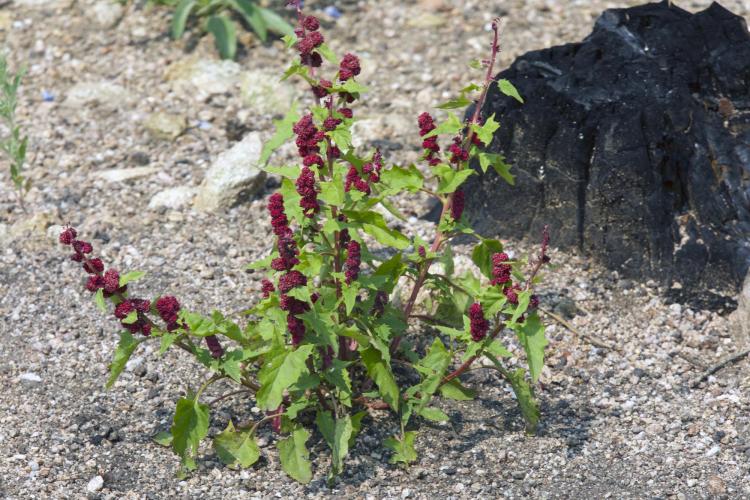Strawberry blite emerging in wake of Cold Springs Fire
Wildfires cause blight, but I found blite
A wildfire causes blight on the land, but it is surprising how quickly plants and animals that depend on them colonize the burned area. Hoping to find blanketflower, Gaillardia aristata, which is one of the first to colonize after a fire, I went to the site of the Cold Springs Fire that burned 528 acres and eight homes near Nederland in July 2016. I found blanketflowers and I found a blite of a different sort.
A population of strawberry blite has colonized the site of the Cold Springs Fire that burned near Nederland in July 2016. Click on photo to see larger image. Photo by Jeff Mitton
Amongst blackened snags and blanketflowers was a thriving population of the plant strawberry blite, Chenopodium capitatum, which I had never seen before. They grew up to 3 feet tall, with several stems emanating from the base. The leaves were bright green, up to 4 inches in the shape of an arrowhead, with edges both coarsely toothed and wavy. Stems were stout and pale red. The fruits were so distinctive I was certain I had never seen this plant before, at least not when it was bearing what looked like berries arranged in bright red clusters on the upper portions of the stems. Each cluster of fruit grew in a leaf axil, or the point where the leaf meets the stem, and the fruits wrapped around the stem.
The flowers lack petals but have three stamens around a green ovary with two lobes at the tip. The flower sits in a cup formed by three sepals (outer covering of the flower bud) that swell and change from green to bright red after the flower is pollinated. Each red fruit contains one brown or black seed.
The display of strawberry blite against the gravel and blackened ponderosa and lodgepole snags was so bright I wondered why I had never noticed strawberry blite before. Reading articles on strawberry blite convinced me there were two reasons for my unfamiliarity. First, it behaves much like a weed, appearing in disturbed sites, such as roadsides and burned areas, but not persisting for very long. Ecologists identify this pattern of occurrence as either weedy or early successional, following disturbance promptly but then giving way to other species as plants begin to compete for space. The literature also indicated that some writers have referred to this species incorrectly as an annual, while actually it is a monocarpic perennial, indicating it lives for multiple years but flowers once, sets seed and dies.
Native Americans found many uses for strawberry blite and so it has other common names such strawberry spinach, Indian paint and Indian ink. Leaves can be eaten raw or cooked like spinach and are considered good sources of vitamins A and C. However, moderation is needed, for the leaves contain oxalates, which interfere with digestion at higher concentrations. The fruits are slightly sweet, perhaps nutty — the similarity to strawberry is in color, not taste. Seeds also are edible, but should be soaked in water overnight to remove mildly toxic saponins.
Native Americans extracted a variety of pigments from strawberry blite. Fruits simmered in water released a pigment that turns the water first pink and then red, and this liquid dye was applied to the skin to make identifying clan symbols or to enhance the color of the cheeks and lips. Fruits were crushed and ground to a red dye paste that was applied as face paint or to paint on wood and skins. When the whole plant was used, extractions yielded either gold or green dyes to be used on clothing.
When we see strawberry blite we are struck with its bright colors. But Native Americans saw much more — edible leaves, fruits and seeds and sources of pigments for cosmetics, clothing, paint and pottery.


